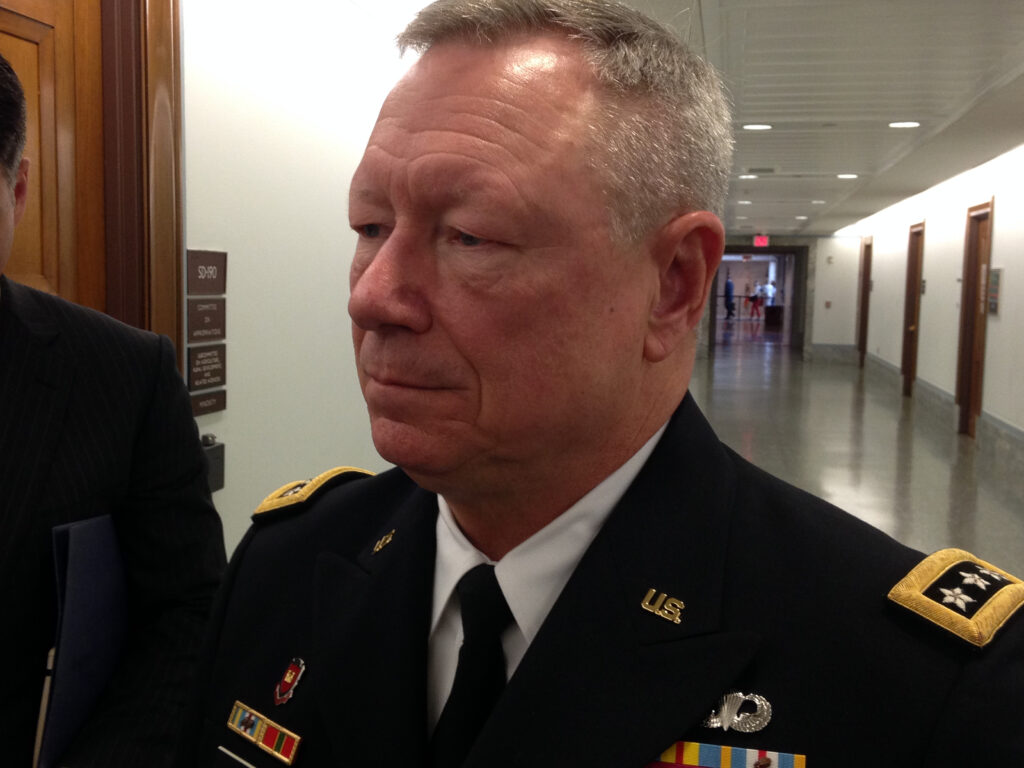Wait For Commission Before Cutting Guard, Gen. Grass Tells SAC-D
Posted on

Gen. Frank Grass
CAPITOL HILL: It’s not every day you hear a member of the Joint Chiefs of Staff asking Congress to undo part of the administration’s budget proposal. But National Guard Bureau director Gen. Frank Grass is in a unique position, the only chief caught between the Pentagon and the states.
So this morning, Gen. Grass explicitly asked the Senate Appropriations defense subcommittee to hold off on any changes to Guard forces or missions — including some changes proposed in the president’s budget — until the congressionally-chartered Commission on the Future of the US Army reports its recommendations next February.
“The problem we’ll have is we will be moving out on 1 October,” Grass told me after the hearing, “unless something happens in the [2016] NDAA; that’s the Congress’s call…..Let’s wait until NDAA ’17, when Congress has an opportunity to act on the recommendations of the report.”
It’s on Oct. 1st, the beginning of fiscal year 2016, that the president’s budget will begin transfer of 36 AH-64 Apache helicopters from the Guard to regular active duty squadrons and an 8,200-soldier reduction in the Army National Guard.
That 8,200-soldier reduction, Grass said, will cost about as much to implement as it would save in fiscal ’16. “We can’t just pull a unit out of a county and leave that county uncovered, because of our homeland mission,” Grass said. So when one unit goes away, another must take on its responsibilities for disaster response, riot control, and so on. “It may not be the same size, but it’ll be a smaller unit that goes in,” he told me.
“Now we have to retrain those [troops], there’re full time staff that get disrupted, there’s families, there’s employers, there’s jobs. And when you cost out the turbulence versus the cost of maintaining that for a year, till ’17, it’s a wash: It’s almost the same amount of dollars,” Grass said. “So why not wait until the Congress has an opportunity to study it in detail this time next year?”
Congress should “definitely lock down the end strength of the Army National Guard at 350,000,” the current figure, without reductions, Grass told the subcommittee.
The Guard Bureau chief was more ambiguous about the Apaches, the most hot-button issue in the Army-Guard debate. Grass emphasized he wasn’t fighting the transfer of 36 Apaches in ’16, let alone get back the 12 transferred already. Those 48 aircraft constitute two of the Guard’s eight attack helicopter battalions, two battalions which he seems (mostly) resigned to letting go. It’s the remaining six he’s hoping to hold onto.
“We’re preparing to move out now…on the reduction of two battalions,” Grass said, but “let’s hold on the six” until the commission reports.
Even states that don’t have Apaches will be affected, he said. When Vermont Senator Patrick Leahy asked, “should we be worried about our Black Hawks?”, Grass replied, “Senator, every state should be worried about the redistribution of assets now.”
But doesn’t the ARI provide the Guard more UH-60 Black Hawks to compensate for losing the Apaches? Yes, Grass told me, but it’s not one-for-one. “The authorization right now for eight battalions of Apaches is 192 aircraft; at best we might get 111 Black Hawks,” he said. “At least up to 20-22 states will lose some capability.”
“The big issue really isn’t about Apaches,” Grass said. “It’s, do we need a combat capability in the Reserve? That’s really what it comes down to. Does the Army need a combat reserve in attack aviation? That’s what I hope the commission takes on.”
Guard advocates fear that removing the Apaches will set a precedent for other combat arms. “We don’t need Bradleys and tanks in the Guard…to respond to the homeland,” Grass said. “But we do need the leaders we’re growing [in those units]. The first unit into Baltimore the other night, the guy that got the mission was an infantry battalion commander — because he knows how to maneuver forces, how to bring ’em together, the logistics it takes to move them.”
Ultimately, though, those Guard combat forces are funded for their federal mission, to deploy abroad for combat when the active-duty regulars are overstretched. They’ve been overstretched plenty in the last 14 years, and Grass is skeptical that will end anytime soon.
“What I really hope the commission will look at in detail is what does the ground force of the United States of America look like in ten to twenty years from now under full sequestration, because that’s the bigger thing that scares me,” Grass said. “That’s not just about the Guard or the active or the reserve, it’s all three of us, and what’s that right balance, given the compensation growth, given the threat around the map.”
Subscribe to our newsletter
Promotions, new products and sales. Directly to your inbox.
